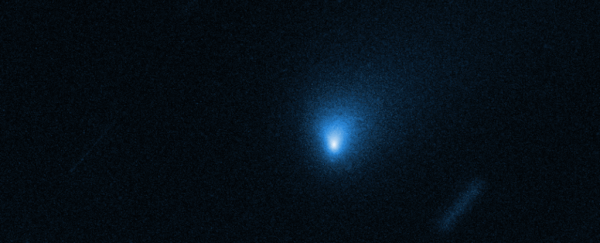Available evidence points to there being a lot of water out there in the Universe, beyond the Solar System. Detecting it and studying it, however, is not exactly easy - unless the water comes to us. Now, some of it has, carried in on a comet from light-years away.
According to a new analysis of 2I/Borisov, submitted to The Astrophysical Journal Letters and uploaded to pre-print resource arXiv, the interstellar comet is outgassing water vapour.
This, in turn, provides information about the comet's nucleus, the volatile elements and compounds it's spewing, and the circumstellar disc from which it originated.
"Comets have a primitive volatile composition that is thought to reflect the conditions present in their formation region in the protosolar disc. This makes studies of cometary volatiles powerful for understanding the physical and chemical processes occurring during planet formation," the researchers wrote in their paper, which is yet to be reviewed.
"The discovery of interstellar comet 2I/Borisov provides an opportunity to sample the volatile composition of a comet that is unambiguously from outside our own Solar System, providing constraints on the physics and chemistry of other protostellar discs."
We've studied a lot of Solar System comets, so we have a pretty decent handle on those processes as they happened during the formation of our own planets, but exoplanetary systems are still a huge mystery. And understanding exoplanets could help us to understand how life emerges in the Universe.
We know Solar System comets are usually quite rich in water; in fact, we think a whole bunch of Earth's water could have been carried in on comets and asteroids.
So, Adam McKay of NASA Goddard Space Flight Center and colleagues took spectroscopic observations of the interstellar comet to try to determine how much water it's carrying. Using the high-resolution ARCES instrument mounted on the Astrophysical Research Consortium (ARC) Telescope in New Mexico, they took two spectra with 1,800-second exposures.
2I/Borisov doesn't emit its own light, but it is lit by the Sun. These spectra break the light from the comet down to its constituent wavelengths. Since different elements and compounds emit and absorb specific wavelengths, this allows scientists to figure out the chemical composition of the gas through which the light is being filtered.
So, in the two spectra, the team observed an absorption line consistent with the presence of water. Based on the strength of this line, the interstellar comet is sublimating a similar amount of water to Solar System comets.
The team then used a simple model to determine that the active water-producing area on the comet is 1.7 kilometres squared (0.65 miles squared) - a proportion of the comet's size consistent with Solar System comets.
Other spectroscopic analyses conducted in the two months since the comet's discovery have found that 2I/Borisov is producing cyanide, and also diatomic carbon - another two substances common in Solar System comets. Based on those analyses, the team said, the proportions in which 2I/Borisov is producing water, cyanide and diatomic carbon also seems really similar to Solar System comets.
The team is very careful to note that their results are based on a model, and that further observations are needed to confirm their findings… but so far, pretty much everything is pointing towards the comet looking really, really familiar.
And that's amazingly cool - because it means the conditions of our Solar System's formation are not unique. Which, extrapolating further, means there could be a whole bunch of other Earths out there.
There's now less than two months before 2I/Borisov reaches perihelion - its closest approach to the Sun - on December 8. It's going to continue to grow brighter in the meantime, so we're looking forward to seeing what new information that reveals about our amazing interstellar visitor.
You can catch up on everything we've learned previously about the comet here.
And the new paper can be read on arXiv.
